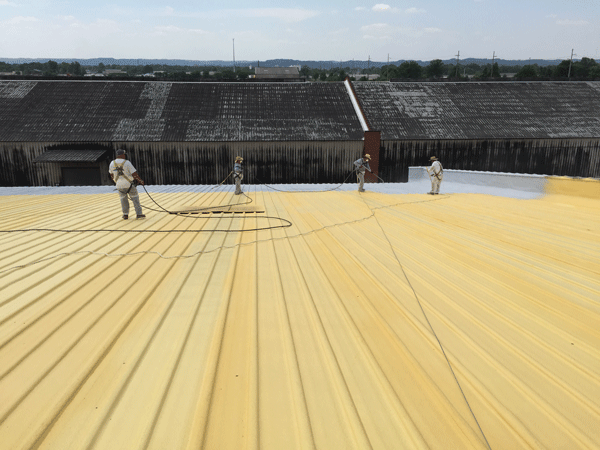It’s “raining on the inside” is never a phrase you want to hear (unless you’re an Amy Grant fan). But that was the message coming from an owner, who wishes to remain unnamed. Under two steep-slope roofs in Louisville, Kentucky, condensation was raining down on the warehouse below.
“Because there was no insulation under the metal panels, the inside of the roof would condensate and begin to drip on product inside the building,” according to Wayne Hampton, Regional VP of Sales of Insulated Roofing Contractors. The two roofs, at 4:12 and 6:12 slopes, required strict safety protocol, a coated insulation system, and a close eye on the weather.
Wind and Light
Over the course of three months, the crew from Insulated Roofing Contractors (IRC) worked on prep, application, and cleanup. The first on the list — prep — took about a third of the entire project. “It was really dirty,” Hampton succinctly said. Some of the metal was covered with a dark debris that had to be removed before the crew could apply the coating. To do that, the crew used 2,000–2,500 psi (13.8–17.2 MPa) machines, along with brushes, to power wash the existing roof panels to remove any large debris.
Next up was to complete any masking needed around the skylights or drains. The crew also used plywood panels to cover each skylight before any foam or coating work was performed. As many know, skylights can be dangerous for workers on the roof if they’re not covered properly. No primer was needed on the buildings, 142,000 and 107,000 square feet (13,192.2 and 9,940.6 m²) respectively, so once the prep work was done, the crew was able to get right to the insulation system.
The spray polyurethane foam (SPF), also called spray foam, went down in one 1.5-inch (2.5 cm) pass. The crew applied Premium’s closed-cell spray foam with a Gusmer GX7 gun attached to a 500-foot (152.4 m) hose. None of the equipment or materials were carried up to the rooftop on the 40-foot (12.2 m) up ladder; instead, they used a lift from Sunbelt Rentals for anything that had to go up top and kept larger items on the ground. Although the IRC crew also used 2x4s (5.1 cm x 10.2 cm) and burlap stretched between them as a wind shield while applying the SPF, the crew had to carry those supplies to assemble up top, too. Wearing face socks, respirators, and safety glasses, they applied the spray foam using the handmade shield, “so that when it was sprayed it didn’t go anywhere,” Hampton said of the SPF.
Rain Delays
On average, the crew from IRC was comprised of six to eight members. The fluctuation depended on the task, but one thing that stayed the same was each person’s role. “There was a ground guy and the rest were on the roof,” Hampton said. Some guys power washing, some spraying foam, some applying the coating, and others attending to the hoses. The process moved along down the length of the rooftop, progressing through each stage of the system. “They overlap; once the power washing was done, those guys went back and helped with other things,” he said.

Wearing Guardian Fall Protection retractable lanyards, the crew clipped into Skyhook Anchors (also by Guardian). “The pitch of the roof was a special concern. It meant that we had to install anchors every 20 feet [6.1 m] on the entrance of the roof to allow workers to hook to one anchor, walk to the next, and change to the next anchor,” Hampton explained. “Everybody was tied off 100 percent. All of these roofs required that — no matter who you were,” he continued.
The crew worked their way down the roofs with the acrylic coating system on top of the SPF. They spray applied the gray acrylic basecoat at an average of 20 mils (508.0 microns), and they covered that with another layer of the white acrylic topcoat at an average of 20 mils (508.0 microns). The products were the same but in different colors.
“This is done to help the workers see where the topcoat is applied,” Josh McKain, marketing director for IRC, said. “If they do gray on gray (or white on white), it’s very difficult to see where you have applied fresh coating and where it’s just basecoat that you’re seeing. Using two different colors is just a way to help the installers ensure they cover the entire surface adequately.”
Clear Skies Ahead
The crew worked safely around the heights. They also had to work safely around any oncoming rain…on the outside of the building. “They were some of the wettest months in recent years in Kentucky,” Hampton said. Therefore, the crew carefully watched the forecast to ensure that they wouldn’t be stuck up top during a storm. They also used the forecast to ensure that any uncured coating wouldn’t be caught in the storm, too. “Once the foam sets up, rain can’t hurt it. But acrylic coatings can be washed away in the rain, wasting time and materials,” he explained. “Work could still be done on days where rain was expected, the crew just had to keep a close eye on the radar.”
As far as Hampton was concerned, the crew did exactly what the client wanted them to do. “They believe in the product and they believe in us,” he said. “That’s why they keep using us on their buildings.” Completing another safe and successful project is the rainbow at the end of the storm. For this client, with no more rain on the inside of these two buildings, it’s nothing but clear skies ahead.
